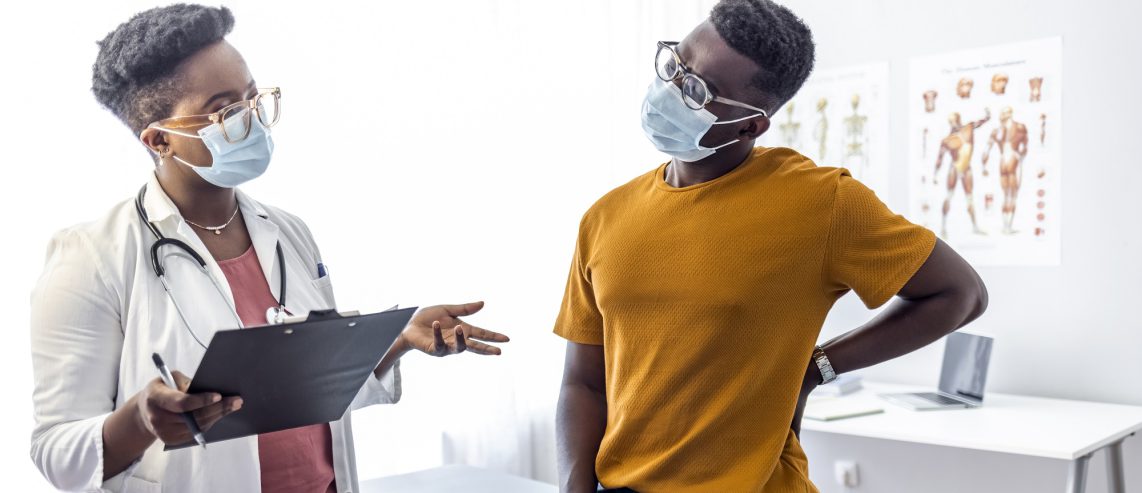Scoliosis — a sideways curvature of the spine — usually begins in childhood or the early teen years. But you can develop or discover scoliosis as an adult, too. Here’s what you need to know about this condition.
What Is Scoliosis?
Scoliosis is an abnormal, sideways curving of the spine. The spine takes on a “C” or “S” shape, making your shoulders or waist look uneven. The curve can be mild or severe.
According to the American Association of Neurological Surgeons, scoliosis affects 2-3% of the population. Doctors usually find it during growth spurts in adolescence. But scoliosis can also develop later in life from wear and tear on the spine caused by aging.
Never Miss a Beat!
Subscribe to Our HealthBeat Newsletter!
Thank you for subscribing!
You can now select the specific newsletters you'd like to receive.
You are already subscribed.
Subscribe to more newsletters in our email preference center.
Sorry, an error occurred. Please try again later.
Get Healthy Tips Sent to Your Phone!
What Causes Scoliosis in Adults?
There are two types of adult scoliosis, and they have different causes. They are:
Adult idiopathic scoliosis
Adult idiopathic scoliosis is a continuation of adolescent idiopathic scoliosis. “Idiopathic” means there is no known cause. This spine curvature may persist through adulthood and worsen as a person ages.
Idiopathic scoliosis may be diagnosed in adulthood because it was missed or untreated in childhood. It’s most common in the upper and middle back. An adult of any age can have this type of scoliosis.
Adult degenerative scoliosis
This type of scoliosis happens as the disks of the spine fall apart. That could be from arthritis, osteoporosis, or spinal stenosis (narrowing the hole in the middle of the spine). It typically occurs in the lumbar region or lower back.
Adult degenerative scoliosis is most common in adults over 65.
Scoliosis Symptoms in Adults
Scoliosis symptoms in adults are due to pinched nerves and continual strain on the lower back and leg muscles. Typical symptoms are:
- Uneven shoulders and hips.
- Low back pain.
- Stiffness.
- Numbness and cramping in the legs.
- Trouble walking.
- Shooting pain in the legs.
- Fatigue.
- Shortness of breath.
- Loss of height.
How is Adult Scoliosis Diagnosed?
Doctors diagnose scoliosis in adults by:
- Asking about your medical history, including family history.
- Asking whether you’re feeling pain, and if so, where.
- Asking about problems with your bladder or bowels. This type of problem could mean nerve damage caused by scoliosis.
- Performing a physical exam to check the shape of your spine.
- Watching how your spine moves when you walk.
- Take x-rays from the front and side of your spine.
Does Scoliosis Get Worse With Age?
If your doctor didn’t treat idiopathic scoliosis when you were a child or adolescent, it can worsen with age. If your spinal curvature as an adolescent was less than 30 degrees, it’s unlikely to deteriorate. If it was over 50 degrees, it’s more likely to get worse.
Degenerative scoliosis typically doesn’t begin till after age 65. Arthritis, osteoporosis, and spinal stenosis can be factors in adult degenerative scoliosis.
Treatments for Adult Scoliosis
If your curvature doesn’t cause pain or loss of movement, it may not require treatment. Treatment for scoliosis in adults typically focuses on the symptoms. Treatment depends on your pain level and how much your problems interfere with your daily activities.
Treatment for adult scoliosis may include:
- Observation. Your doctor will see you every few years to see if your curvature has worsened.
- Physical therapy. Core exercises can strengthen the back and abdomen muscles and improve your flexibility. Low-impact workouts like swimming can also help. Your physical therapist may add yoga and stretching exercises to your routine.
- Medication. Your doctor may prescribe pain medications or recommend over-the-counter meds.
- Epidurals or nerve block injections can provide greater pain relief if needed.
- Braces. In adults, braces are a short-term fix only. Wearing a back brace for too long can weaken core muscles and worsen symptoms.
- A plan to quit smoking. Smoking speeds up the degeneration of the spine.
- Surgery. Spinal surgery is usually the last resort for treating adult scoliosis. There are different surgical options, including minimally invasive spinal surgery. The goal is to stabilize the spine, help your balance, and relieve pressure on the nerves to diminish pain.
Sources
About Neurosurgery
The UPMC Department of Neurosurgery is the largest academic neurosurgical provider in the United States. We treat conditions of the brain, skull base, spine, and nerves, including the most complex disorders. We perform more than 11,000 procedures each year, making our team one of the most experienced in the world. Whether your condition requires surgery or not, we strive to provide the most advanced, complete care possible. Our surgeons are developing new techniques and tools, including minimally invasive treatments. Find an expert near you.
